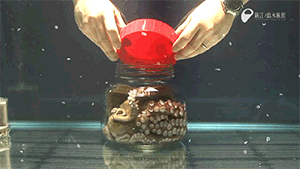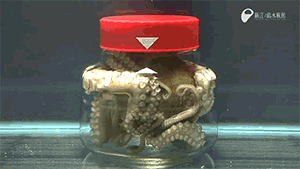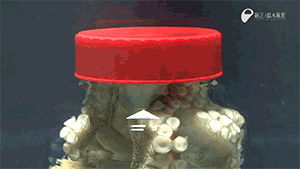Scientists Attached A Video Camera To Humboldt Squid In Order To Observe How They Use Their Color-changing

Scientists attached a video camera to Humboldt squid in order to observe how they use their color-changing skin cells in the wild.
Analysis of the footage revealed that the squid repeatedly flash red in the presence of other Humboldt squid, possibly as a way of communicating — though what, scientists aren’t yet sure. When close to the surface, the squids’ chromatophores flicker, giving their skin a hue of sunlight shining through the water column — possibly as a form of camouflage.
More: Science News
Reference: Rosen et al. 2015. Chromogenic behaviors of the Humboldt squid (Dosidicus gigas) studied in situ with an animal-borne video package
More Posts from Sleepysneezeydopeydoc-blog and Others

Carrying 69 Chevys…

God damn it Isaac! 😡😡

Each trig function in terms of the other five: color coded. Idk I’m just playin’ around in LaTeX and thought this table on Wikipedia would be worth color coding on its own so I made this little ditty. The reciprocal functions are the lighter colors of their regular trig counterparts. I wouldn’t call this a final version, but, hey, it’s pretty cute. High five for pattern recognition.
Coin flip.
“One of the hardest decisions you’ll ever face in life is choosing whether to walk away or try harder.
Ziad K. Abdelnourp







Alloys: Bronze
Given that there are many different types of bronze with a wide variety of elements included, the alloy cannot be defined as having one set composition. Though the most well known bronze is likely the common copper-tin alloy, alloys such as bismuth bronze, silicon bronze, and aluminum bronze don’t necessarily contain tin.
That being said, the most well known bronze alloy, and the one most people probably think of when they hear the word, is composed of mostly copper with tin or arsenic and, potentially, small amounts of other elements. The oldest tin-copper bronze alloys found are from around 4500 B.C., and this replacement of stone tools with bronze eventually led to the Bronze Age. (The Bronze Age eventually gave way to the Iron Age, because, despite bronze’s favorable properties, iron is more plentiful and easier to find.)
The addition of tin, arsenic, and other elements produces a harder material than copper alone. Bronze also has the favorable properties of being corrosion resistant, non-magnetic, has excellent heat transfer properties, is relatively easy to machine, withstands high temperatures, and is resistant to wear and friction. Unlike steel, bronze does not spark when struck and is therefore useful as tools in environments containing flammable vapors.
Some historical applications of bronze include in statues, weapons and tools, and currency/coinage. The alloys is also well known for is usage in musical instruments, often bells and cymbals, as well as the windings of string instruments such as the guitar and piano.
Sources: ( 1 ) ( 2 ) ( 3 ) ( 4 ) ( 5 )
Image sources: ( 1 ) ( 2 ) ( 3 )

There is a Diamond ExoPlanet and it’s worth is $26.9 Nonillion.
If we stacked all that money in $50 notes, this would be the outcome. The earth(on the left at the bottom) is used for size comparison.
$26.900,000,000,000,000,000,000,000,000.000

Golf Ball 70,000fps 150mph.
The straight up physics of deformation at high speeds is fascinating. Although what is also fascinating is the one thing we really take for granted. TIME. The high frames per SECOND is the only thing that makes this possible to view.
This is a visual example of what happens when you can see TIME, AND physics. I think we forget how important time is in our lives, yet it’s one of the most fascinating. Without time you have no-thing.

Olds 88… 1956 tail light

-
 solsticesoup reblogged this · 4 years ago
solsticesoup reblogged this · 4 years ago -
 solsticesoup liked this · 4 years ago
solsticesoup liked this · 4 years ago -
 chainsawshark reblogged this · 4 years ago
chainsawshark reblogged this · 4 years ago -
 chainsawshark liked this · 4 years ago
chainsawshark liked this · 4 years ago -
 bachatanero liked this · 7 years ago
bachatanero liked this · 7 years ago -
 grievance-s liked this · 7 years ago
grievance-s liked this · 7 years ago -
 shadyalpacakingdom-blog1 reblogged this · 7 years ago
shadyalpacakingdom-blog1 reblogged this · 7 years ago -
 shadyalpacakingdom-blog1 reblogged this · 7 years ago
shadyalpacakingdom-blog1 reblogged this · 7 years ago -
 shadyalpacakingdom-blog1 liked this · 7 years ago
shadyalpacakingdom-blog1 liked this · 7 years ago -
 proudthereminmom liked this · 7 years ago
proudthereminmom liked this · 7 years ago -
 cosmicpinkoreo liked this · 7 years ago
cosmicpinkoreo liked this · 7 years ago -
 marshallfumblr reblogged this · 7 years ago
marshallfumblr reblogged this · 7 years ago -
 glitteringpileoftrash liked this · 7 years ago
glitteringpileoftrash liked this · 7 years ago -
 brucewombs liked this · 7 years ago
brucewombs liked this · 7 years ago -
 theconstantstateofwonderlust reblogged this · 7 years ago
theconstantstateofwonderlust reblogged this · 7 years ago -
 theconstantstateofwonderlust liked this · 7 years ago
theconstantstateofwonderlust liked this · 7 years ago -
 station24 liked this · 7 years ago
station24 liked this · 7 years ago -
 sierracolorstheworldofwords reblogged this · 7 years ago
sierracolorstheworldofwords reblogged this · 7 years ago -
 sierracolorstheworldofwords liked this · 7 years ago
sierracolorstheworldofwords liked this · 7 years ago -
 evolutionarytravesty reblogged this · 7 years ago
evolutionarytravesty reblogged this · 7 years ago -
 freeat56 reblogged this · 7 years ago
freeat56 reblogged this · 7 years ago -
 herinternetdaze liked this · 7 years ago
herinternetdaze liked this · 7 years ago -
 argonautexplorer liked this · 7 years ago
argonautexplorer liked this · 7 years ago -
 pinkpizzauniverse liked this · 7 years ago
pinkpizzauniverse liked this · 7 years ago -
 nan-do liked this · 7 years ago
nan-do liked this · 7 years ago -
 protecttheplants liked this · 7 years ago
protecttheplants liked this · 7 years ago -
 randyranks reblogged this · 7 years ago
randyranks reblogged this · 7 years ago -
 randyranks liked this · 7 years ago
randyranks liked this · 7 years ago -
 nightbat13131 liked this · 7 years ago
nightbat13131 liked this · 7 years ago -
 local-star-witch reblogged this · 7 years ago
local-star-witch reblogged this · 7 years ago -
 dakatndahat liked this · 7 years ago
dakatndahat liked this · 7 years ago -
 fiftypapayas liked this · 7 years ago
fiftypapayas liked this · 7 years ago -
 bluehoodedhuntress reblogged this · 7 years ago
bluehoodedhuntress reblogged this · 7 years ago -
 daddybug420 liked this · 8 years ago
daddybug420 liked this · 8 years ago -
 sapphires-little-cave reblogged this · 8 years ago
sapphires-little-cave reblogged this · 8 years ago -
 saldanalordofruin liked this · 8 years ago
saldanalordofruin liked this · 8 years ago -
 thelandofcuriosities liked this · 8 years ago
thelandofcuriosities liked this · 8 years ago -
 cupspercake liked this · 8 years ago
cupspercake liked this · 8 years ago -
 creme-inyour-coffee reblogged this · 8 years ago
creme-inyour-coffee reblogged this · 8 years ago -
 pirateladyoftherbbc liked this · 8 years ago
pirateladyoftherbbc liked this · 8 years ago -
 maneatingcarrots reblogged this · 8 years ago
maneatingcarrots reblogged this · 8 years ago -
 maneatingcarrots liked this · 8 years ago
maneatingcarrots liked this · 8 years ago